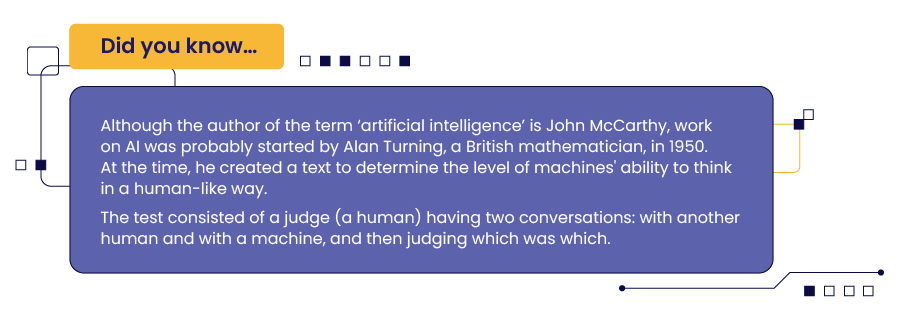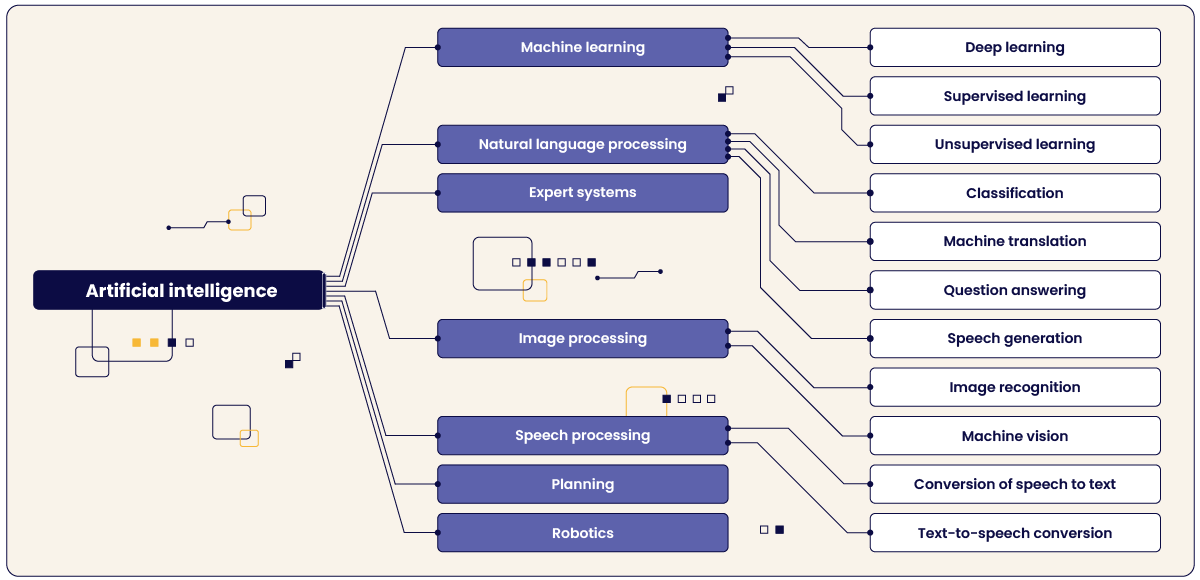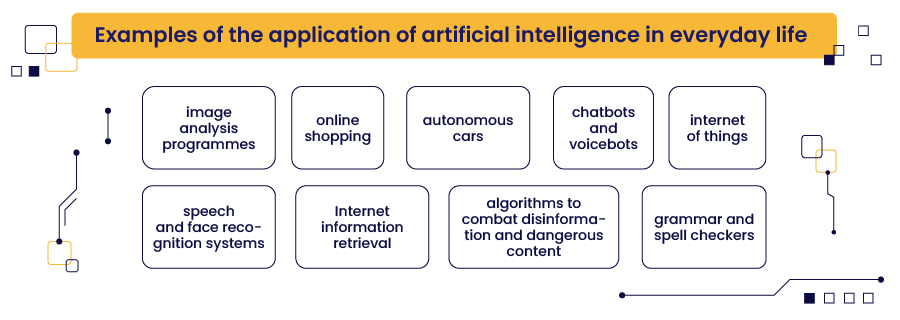Artificial intelligence. This topic hasn’t even left us for a good few years. It’s a really fast-growing area of technology. Still, however – or maybe because of that – it remains a difficult puzzle for many people. After all, proven information isn’t all that plentiful. And even so, most of the information describing the basics of AI quickly becomes obsolete. Nevertheless, I have tried to gather in one place the most important information about AI: definitions, applications, benefits. In this way, it will be easier to assess the impact of the operation and application of artificial intelligence on our reality – now and in the future..
Decoding artificial intelligence, or what is AI?
I will venture to say that although we are all inundated with information about AI every day (guilty!) and we ourselves still flip-flop with statements that AI this, artificial intelligence that, it’s hard to be sure if we are using the term correctly. .
Ot, we have clung to that artificial intelligence (AI), and its boundaries from the beginning not entirely clear and understandable have systematically become even more blurred. .
So let’s start with a definition and an answer to the question: what is AI. And no, we’re not going to talk about Illustrator file extensions from Adobe here.
Trying to explain what artificial intelligence is poses many challenges to the interpreter. Especially since AI, i.e. artificial intelligence, can be understood in two ways, among others:.
-
- purely theoretically as an intelligence that is driven by a technical process,
- as a term for technology and at the same time a diverse field at the intersection of computer science, cognitive science, psychology, neuroscience or philosophy.
Artificial intelligence (artificial intelligence) is a term that describes the ability of machines, tools or applications to exhibit skills inherent in humans and for years attributed only to them. This includes the ability to reason, learn, plan, adapt to change, infer, and even think creatively.

Since when do we talk about artificial intelligence (artificial intelligence) and to whom do we owe it?
Nothing ever happens without a cause and is born out of nothing. Unless we’re talking about mythology, in which Gaia and Uranos rose from Chaos, and gods were able to pop out of their heads or emerge from sea foam….
With AI, however, it was different. So let’s introduce the basics of AI..
Officially, the beginning of the Internet is considered to be 1969, you probably know that. Imagine, then, that according to sources the concept of artificial intelligence was first used in 1956which is as much as 13 years earlier! The authorship of the term is attributed to John McCarthy, an American computer scientist. However, the father of artificial intelligence (AI) is British mathematician Alan Turing..
Interestingly, his nearly 70-year-old definition still applies. McCarthy stated at the time that artificial intelligence is the construction of machines whose operation could be said to be similar to human manifestations of intelligence..

Why is artificial intelligence important?
Artificial intelligence, or AI as we more commonly say, has for years been cited as a major trend that most other fields are trying to leapfrog and, as it were, capitalize on the glow of its glory. .
AI is a technology with which the future of the world is tied.
Today, almost every day there are breakthroughs related to data accessibility (we know something about that ), computing power is growing, and new algorithms can stir up the most unexpected moment. When it comes to the changing digital transformation framework, there really is no boredom.
Artificial intelligence and what we include in it
You already know that artificial intelligence is an extremely broad term. So see what – according to the report Game-changing technologies: Transforming production and employment in Europe – makes up the whole of artificial intelligence:.

Lots of it, right? No wonder AI is going all white in so many areas of human life .
Unfortunately, there is a pitfall in this diversity. For it turns out that it is very common to use all the terms included in the chart interchangeably.
Example: we say artificial intelligence, when what we really mean, for example, is natural language processing or machine learning. I will not explain all the above terms in this text, but I will try to explain the ones used most often in the simplest way possible..

Machine learning
Machine learning (eng. machine learning) is one subset of artificial intelligence (eng. artificial intelligence). It relies on the fact that algorithms “learn” from the data entered into them.
It can be said that it is an endless process, as algorithms evolve as they receive new information and thus improve their performance. An important feature of machine learning, however, is that any process of algorithm improvement is not programmed in any way. Algorithms are developed in such a way that they find patterns and make the most appropriate decisions on their own – based on the data obtained..
Machine learning thus resembles… a human being who, in the course of education, acquires more information, builds his own databases and uses them to make choices..
Natural Language Processing (NLP)
This is the second of the most popular subset of AI builders. NLP makes computers more and more capable of handling the language humans speak every day.Understanding is not enough, however. Thanks to natural language processing, computers can also speak the language – both spoken and written.
This is how all virtual assistants, such as Siri and Alexa, among others, were created.
Basics of AI – applications of artificial intelligence
Since I’ve already mentioned Siri or Alexa, it’s time to quickly mention some other examples of the uses of artificial intelligence that accompany us all in our daily lives:.
-
- image analysis software,
-
- speech and face recognition systems,
-
- internet of things,
-
- chatbots and voicebots,
-
- algorithms to combat disinformation and dangerous content,
- grammar and spell-checking software.
Additionally, artificial intelligence accompanies you during:.
-
- doing online shopping – these personalized prompts while bussing through the websites of various online stores don’t come about by chance. They are the result of analyzing, for example, your search engine history or general online behavior.
- searching for information on the Internet -Google’s mission is to make search results as relevant as possible, to respond to users’ needs and intentions. To that end, the tool is constantly processing huge amounts of data to best understand what Internet users are looking for. For this reason, every now and then we have to deal with changes and updates to the search engine.
- driving a car – I am not a driver, but I know that modern cars are equipped with more and more new technological solutions, including those based on the achievements of artificial intelligence. As an example, there are sensors that catch dangerous situations on the road.
If you didn’t have enough examples of the everyday application of artificial intelligence (eng. artificial intelligence), let me remind you that AI took an active part in the fight against pandemics. Specifically, it was used, for example, at airports for thermal imaging or to generally predict possible scenarios for the spread of the virus. .
And there was plenty to do in this regard!.

Benefits of using AI at work and in life
As you can see, applications of artificial intelligenceare very different. All of them bring many benefits to today’s world and society.
I’ll start by listing the 3 benefits that seem most important to me.
-
- Increased ability to automate multiple processes
Bringing repetitive, pattern-based tasks into the hands of artificial intelligence has given employees at many companies the space to do the things that really matter. And this in turn has led (and continues to lead) to greater productivity and performance. .
Example? With Senuto’s AI-based keyword management feature, you do better phrase research, and spend much less time doing it.
-
- Easier to solve complex problems
Here the honor and glory should be given to machine learning and deep learning models. It is their constant improvement that makes us able to solve complex problems, understand difficult issues or face new challenges faster, more efficiently and more effectively.
-
- Faster development of technology and fields such as business or medicine
As we get better at dealing with problems or challenges, we are able to develop our world much faster. Just look at what is happening in the world of medicine – remote diagnosis, safe health monitoring or predicting the development of epidemics. All of these things work in our favor in the long run.
Other benefits we can also include:.
-
- make better decisions based on data,
-
- personalized user experience,
-
- increased safety, such as with smart systems in cars,
-
- possibility of applying AI in providing (cyber)security to citizens,
-
- increased efficiency,
-
- simplify processes,
- more efficient analysis of large data sets.
How does artificial intelligence work in marketing?
On the one hand, I know that a little has already been said, explained and shown by example in this text, but I am still plagued by a sense of insufficiency.
This is why I will now try to show, how artificial intelligence works in marketing. How you can use it and for what. .
Data analysis.
Sounds like a tedious job, right? And indeed it is. That’s why it makes sense to opt for artificial intelligence support here. It is it will dig” through millions of databases for you and, based on that, will suggest, for example:.
-
- what trends and correlations can be spotted in your business, and then use them to plan new products or even type customers who are most likely to make a purchase,
-
- how to plan remarketing activities,
- when and where ad optimization is necessary.
Image and video creation.
I know this is a somewhat controversial topic, but look on the bright side. AI has opened the floodgates of greater independence – which is of great value especially in the early stages of starting a business. You don’t need to hire employees or agencies to generate graphics, logos or simple videos for social media, for example..
Customer service.
In this area you can really go wild with the use of AI. Chatbots, voicebots or automatic translations from language to language – you will really take a lot of responsibilities off your customer advisors this way. And this will enable them to devote more time to fine-tuning details, streamlining processes and finding new ways to reach customers. .
Content creation.
AI can be a great support in working on text. For example, the AI running in Senuto’s Writer is responsible for, among other things, managing phrases and generating the most relevant recommendations for texts to rank at the top of the search engine. .
That’s not all, however. Artificial intelligence will also help you develop a plan for the text, its content and meta data, for example. And it will also generate copy for you for social media posts, image descriptions or any other text you need..
Summary
I know that the information explaining the operation and application of artificial intelligence is both plentiful and scarce at the same time, and on top of that, some of it manages to be… mutually exclusive. And if that weren’t enough – AI is changing so fast that many elements are becoming obsolete. Nonetheless, it is worth taking the time to implement into this reality in order to freely navigate the exciting possibilities of artificial intelligence. Its applications offer a truly immense scope, and the possibilities seem almost limitless..
What is AI?
AI, i.e. artificial intelligence (eng. artificial intelligence), is a branch of computer science that, based on the study of human behavior, creates programs or computer systems based on similar principles and imitating the way people think. .
How does artificial intelligence work?
In the broadest terms, we can say that any program or system based on artificial intelligence (AI) works according to the following scheme:.

This is possible because individual systems systematically create dependencies and interactions between algorithms – exactly as it happens in the human brain. This is exactly the principle on which our internal neural networks work.
The methods used to develop artificial intelligence can include:.
-
- Supervised learning – i.e., we rely on data. We feed AI algorithms with data (e.g. photos) and thus teach it in recognizing people, things or places.
- Unsupervised learning – here the AI analyzes the collected data and, according to its algorithms and existing knowledge, divides it into groups or catches connections.
- Science before amplification – here it’s really about using algorithms in practice. You’ve probably noticed, for example, that GPT chat, as one “conversation” goes on, is based on all the clues that appear in it. As a result, it generates increasingly accurate answers.
.
 Iza Sykut
Iza Sykut